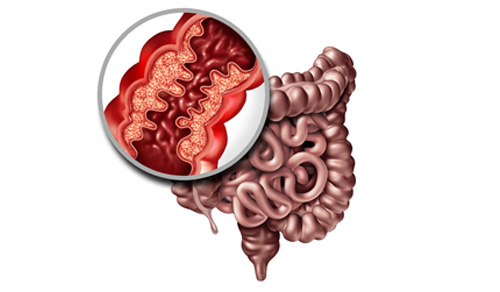NewYork-Presbyterian/Weill Cornell Medicine gastroenterologists are leading pivotal research into new and better treatments for Crohn’s disease. Finding the optimal treatment that works for patients with this chronic disease is of utmost importance following a diagnosis to prevent disease progression and complications. Medications commonly used to treat Crohn’s include immunomodulators, corticosteroids, biologics and biosimilars, aminosalicylates, antibiotics, and, in the near future, targeted synthetic small molecules. Despite these available options for Crohn’s treatment, many of these therapies come with high rates of primary non-response, loss of response, and adverse reactions necessitating the discontinuation of treatment.
Intestine showing inflammation that occurs in patients with Crohn’s disease
“Crohn’s disease affects each patient in a unique way, from clinical presentation to progression,” says Dana Lukin, MD, PhD, a gastroenterologist and the Clinical Director of Translational Research for the Jill Roberts Center for Inflammatory Bowel Disease at NewYork-Presbyterian/Weill Cornell Medicine. “There are many potential triggers and genetic associations that may vary from individual to individual. Therefore, the driver of the disease may also vary between patients. Antibiotics, corticosteroids, and aminosalicylates do not prevent progressive bowel damage. While the advent of TNF-alpha antagonists represented a significant advancement in therapy, around one-third of patients will not respond to these agents, and responders may lose response over time. Therefore, there is a great need for immune modulating medications utilizing other mechanisms of action, such as ustekinumab, in Crohn’s disease.”
Ustekinumab is the only biologic approved to treat moderately-to-severely active Crohn’s disease that targets interleukin-12 (IL-12) and interleukin-23 (IL-23) cytokines. IL-12 and IL-23 promote proinflammatory processes resulting in the expansion of two types of T cells (INFgamma Th1 cells and Th17 cells), which have been implicated in the pathogenesis of Crohn’s disease. Ustekinumab specifically targets the p40 subunit shared by IL12/IL23 and inhibits both cytokines, thereby decreasing inflammation.
Dr. Dana Lukin
“Ustekinumab has a more targeted mechanism than TNF-antagonists and has an excellent safety [profile] and efficacy in Crohn’s disease,” says Dr. Lukin. “It is, therefore, a great option for first-line biologic therapy in Crohn’s disease. As heterogeneous inflammatory pathways affect Crohn’s disease, having multiple therapeutic mechanisms for treatment is essential. In addition to those who do not have primary response to TNF-antagonists, in some patients it is believed that the mechanism driving the disease process can shift, resulting n a loss of response to these therapies. Therefore, second-line therapy with ustekinumab also represents a powerful treatment option.”
Real-world evidence shows safety and efficacy
Dr. Lukin and Ellen Scherl, MD, the Jill Roberts professor of inflammatory bowel disease at Weill Cornell Medicine, were among peers from other institutions conducting a retrospective analysis of the IBD Health Outcomes Consortium substudy group (SUCCESS), a multicenter, multinational consortium of Crohn’s patients receiving ustekinumab.
“As with the VICTORY Consortium investigating vedolizumab in the real-world, the SUCCESS Consortium provided an opportunity to study the safety and effectiveness of a newly approved medication within a heterogeneous population and study predictors of response. This publication represents the first of several planned analyses studying the real-world usage of ustekinumab,” says Dr. Lukin.
Randomized controlled trials previously demonstrated the efficacy and safety of ustekinumab as both induction and maintenance therapies; however, there is limited data on its real-world use since it became available commercially. Drs. Lukin and Scherl and the other researchers sought to gather that data through the SUCCESS Consortium to gain real-world evidence supporting the drug’s use.
“Many patients are excluded from randomized, controlled clinical trials, including those with fistulizing disease, those using concomitant excluded medications, those having exposure to more medications than were allowed into the registration trials, and those with other unique exclusions,” says Dr. Lukin. “The SUCCESS Consortium demonstrates that the performance of ustekinumab following its approval was similarly safe and effective as that seen in the UNITI-IMUNITI trials. Furthermore, it will allow for subsequent comparative effectiveness studies to investigate the relative safety and performance in relation to other medications in clinical use, such as TNF-antagonists and vedolizumab, using propensity-score matched cohorts. Additionally, the registration trials did not allow for treatment escalation or use of off-label dosing intervals whereas the SUCCESS Consortium will allow for study of additional intravenous induction doses and shorter maintenance intervals.”
This study was the largest observational ustekinumab cohort published to date. A total of 1,113 patients (90% of whom had previous biologic exposure) were included in this study by meeting the following inclusion criteria:
- They had a confirmed diagnosis of Crohn’s based on clinical, endoscopic, radiographic, and/or histologic data;
- They had active clinical symptoms attributed to Crohn’s before initiating ustekinumab; and
- They had at least one clinical, endoscopic, and/or radiographic follow-up after starting the medication.
Patients were excluded if they received subcutaneous injection induction as opposed to intravenous induction; those treated off-label before ustekinumab received FDA approval; those with Crohn’s of the ileoanal pouch; and those who originally started ustekinumab for an indication other than Crohn’s.
The primary effectiveness was measured by cumulative rates of clinical and endoscopic remission at the 6-month and 12-month mark. Secondary effectiveness measurements included cumulative rates of corticosteroid-free remission, loss of remission, and durable remission.
The findings showed that at 12 months, the cumulative rates of clinical, endoscopic, steroid-free, and radiologic remission rates were 40%, 39%, 32%, and 30% respectively. In patients that had active disease at drug induction, cumulative rates of endoscopic remission at 6 and 12 months were 17% and 39% respectively.
The study also showed, for the first time, that dose optimization of ustekinumab was effective in attaining a therapeutic response for 40% of patients with primary nonresponse or incomplete response and 57% with secondary loss of response
This data can help to inform the real-world safety of escalated dosing and speak to optimization of ustekinumab in clinical practice. Such data are critical to providing data to payors to approve higher-than standard dosing and harnessing the full therapeutic potential of ustekinumab.
— Dr. Dana Lukin
Previous studies examined predictors of clinical response to other medications to treat Crohn’s disease; however, less is known about what factors may influence therapeutic response to ustekinumab. The researchers in this study found that biologic naïve patients achieved higher rates of clinical (63%) and endoscopic (55%) remission at 12 months and experienced only a 9% loss of remission rate over 6 months. On the other hand, those who were treated previously with biologics, like TNF-α antagonists, had a lower probability of achieving remission and experienced increased loss of remission rates. Specifically, in patients who were on 1, 2, 3, or 4 biologics previously had loss of remission rates at 10%, 25%, 28%, and 47% respectively.
“These results provide confidence that ustekinumab performs well in the real-world with similar safety and effectiveness as those seen in the UNITI-IMUNITY trials. As seen in these trials, biologic-naïve patients responded best, but those with prior exposure also showed favorable response rates. The optimization data are very important with regard to real-world usage of medications, and these data were not studied in the registration trials,” says Dr. Lukin. “This data can help to inform the real-world safety of escalated dosing and speak to optimization of ustekinumab in clinical practice. Such data are critical to providing data to payors to approve higher-than standard dosing and harnessing the full therapeutic potential of ustekinumab.”
The relationship between serum concentration and radiologic remission
While this study demonstrated that ustekinumab can induce radiologic remission, no data previously existed to show the relationship between ustekinumab serum concentrations and radiologic remission. In another study, Weill Cornell Medicine faculty sought to understand the medication concentrations necessary to achieve radiologic remission.
Drs. Lukin and Scherl worked with Randy Longman, MD, PhD, director of the Jill Roberts Center for Inflammatory Bowel Disease, and Johnson Chen, MD assistant professor of clinical radiology at Weill Cornell Medicine as well as Robert Battat, MD, a gastroenterologist and associate professor of medicine at Université de Montréal, to establish a relationship, for the first time, between ustekinumab serum concentrations and radiologic remission measured through magnetic resonance enterography (MRE) using the Simplified Magnetic Resonance Index of Activity (sMARIA) score.
When measured previously using homogenous mobility shift assays (HMSAs), data showed higher serum concentrations of 3.75 to 4.5 μg/mL were necessary for positive endoscopic and biomarker outcomes. The Weill Cornell team found that even higher ustekinumab concentrations, 6.1 to 8.4 μg/mL, were associated with radiologic remission and absence of severe inflammation using sMARIA scores.
“Therapeutic drug monitoring (TDM) of TNF-antagonists has been demonstrated to provide a clear relation of serum medication levels and clinical outcomes. The role of TDM with newer biologics, such as vedolizumab and ustekinumab, is less clear,” says Dr. Lukin. “While our clinical guidelines emphasize the attainment of clinical and endoscopic remission, newer guidelines such as STRIDE-II, have discussed deeper targets, including transmural healing, as potential long-term or aspirational targets of therapy.
“The sMARIA score is one validated, objective scoring system to assess disease activity in Crohn’s disease using MRI data. As with other forms of deep healing, such as perianal fistula remission, these data show that higher serum levels of ustekinumab are required to achieve radiologic remission and provide a goal for those patients for whom this is a relevant clinical target.”





